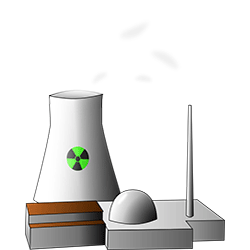
Nuclear power plants provide a very large amount of the power needed to produce electricity for the worlds electricity needs. Sometimes we will hear bad things about these types of power plants. Yes, there have been some very bad incidents like the one that is called the Chernobyl disaster, which has left us some very important lessons to learn.
Since that incident all the required precautions are now taken to ensure that all of our modern nuclear power plants are completely safe and that type of incident will never happen again. In fact, nuclear power plants are actually pretty safe of them. Inside the nuclear power plant, the entire power plant is designed to be encased inside a very thick and dome shaped building structure as one of the power plants safety measures.
So now that you have read a little about nuclear power plants I am sure that you would like to know exactly how one actually works.
Here’s how a Nuclear Power Plant Works:
A nuclear power plant is powered by something called Uranium in a process that is known as nuclear fission. In nuclear fission uranium atoms are split to produce a very large amount of energy that is eventually converted into heat.
The very huge amount of heat that is created in this process then boils water so that in can produce steam that is then used to rotate huge turbines. These turbines then spin the shaft of a generator. As this generator gets started working, the coils of wire from within this generator are then spun in a large magnetic field and that produces electricity.
A nuclear reactor will maintain & control the nuclear reaction that happens in the nuclear power plant to produce needed energy. There are several different types of nuclear reactor type power plants. There are PWR nuclear reactors, also called a Pressurized Water Reactor, a BWR, which is also called a Boiling Water Reactor, a PHWR, also called a Pressurized Heavy-water Reactor, an AGR, which is also called an Advanced Gas-cooled nuclear Reactor, etc.
PWR – Pressurized Water Reactor Power Plants
In highly pressurized water reactors found in these type of power plants, ordinary water will function as the moderator as well as the coolant for the reactors. The power plants main cooling circuit will flow through it’s core to the reactor under very high pressures, then the steam that is created in the secondary circuit drives the turbines. The water that is in the reactor core can reach a temperature of 617 °F and so, the water inside is kept under approximately 150 times our atmospheric pressure to help prevent the water from boiling.
PHWR – Pressurized Heavy-Water Reactor
In a pressurized heavy-water reactor, the moderator is located inside a very large tank that is called a calandria. This tank is penetrated by pressure tubes that are horizontal and these act as fuel channels for the reactor. The calandria is cooled off by the flow of very high-pressure heavy water inside the primary cooling circuit of the reactor unit. The steam, that then drives the turbines in the plant, is generated by the reactor’s secondary circuit. The design of it’s pressure tube will allow the power plants reactor to be easily refueled simply by just isolating each of the pressure tubes of the cooling circuit. There is no need to have to shut the reactor down to refuel it.
BWR – Boiling Water Reactor
In a boiling water reactor, the top part of the reactor’s core operates with about 15% water to create the steam it will need. This steam that is created then will go directly into the turbines by way of drier plates that are located above the reactor core. In these type of nuclear reactors, the water around the reactor’s core is usually contaminated with what is called radionuclides. Therefore, the plants turbines have to be shielded well by radiological protection during any type of maintenance of the nuclear fission power plant. The money that is saved due to this type of plants simple design is spent on the needed shielding. This helps to balance the costs that are incurred in the plants construction.
In the United States there are pressurized water reactor type power plants and boiling water reactor type power plants that are used to provide our nuclear power. Even though a few security concerns exist about the operation of our nuclear power plants, they are very necessary to help cope with our constantly-increasing energy requirements.
Due to low levels of emission from nuclear power plants, they are a very cost-effective source of power that is steadily becoming very popular to use. As a matter of fact, the nuclear energy that will be used for electricity production is predicted that it will increase by more than 20% by the year 2030.
If you have a question or comment on the article above the please feel free to leave us a reply below.





